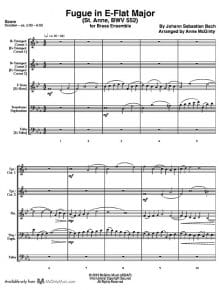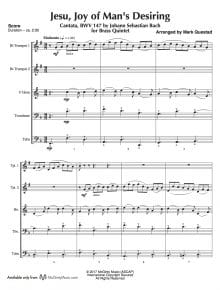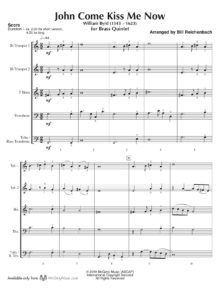Search Music
Music Categories
PDF Download Only
Purchase. Print. Play.
-
Fugue in E-Flat Major (J.S. Bach) – Large Brass Ensemble
“The triple fugue … is a symbol of the Trinity. The same theme recurs in three connected fugues, but each time with another personality. The first fugue is calm and majestic, with an absolutely uniform movement throughout; in the second the theme seems to be disguised, and is only occasionally recognisable in its true shape, as if to suggest the divine assumption of an earthly form; in the third, it is transformed into rushing semiquavers as if the Pentacostal wind were coming roaring from heaven.” ~ Albert Schweitzer
The Fugue in E-Flat Major (BWV 552) has become known in English-speaking countries as the “St. Anne” because of the first theme's resemblance to the St. Anne hymn O God, Our Help in Ages Past, a hymn that would have been unknown to Bach. A fugue in three sections of 36 bars, 45 bars and 36 bars, with each section a separate fugue on a different theme, it has been called a triple fugue, although only the first theme is combined with the second and third themes; for that reason the second and third sections are sometimes referred to as double fugues. The number three is pervasive and has been understood to represent the Trinity. The description of Albert Schweitzer follows the nineteenth century tradition of associating the three sections with the three different parts of the Trinity. The number three, however, occurs many other times: in the number of flats of the key signature; in the number of sections; and in the number of bars in each section, each a multiple of 3 x 3. Each of the three themes of the fugues seems to grow from the previous ones.
Written for organ, the ranges of each of the five fugal voices works well for the five brass instruments. Articulations and minimal dynamic suggestions have been added to honor the music, to make it sound as it would have sounded if the fugue were conceived for these modern instruments.
This fugue is available for brass quintet as well as brass ensemble. There are Eb trumpet parts included with the brass quintet version. The brass ensemble version has the traditional brass quintet parts, Eb trumpet parts, Eb horn, Euphonium TC and Eb tuba.
Composer: Anne McGinty
Instrumentation: 2 Bb and/or Eb Trumpets, F and/or EbHorn, Trombone and/or Euphonium & Tuba
Duration/# of Pages: ca. 5:30 / 38 pages, 8.5″ x 11″
Key: Eb -
Illusions – Mixed Quintet
Illusions make us think we are seeing something we’re not, a deception, which is quite magical; and this piece is based on magic.
The first movement, Wild Card, depicts the journey to find one’s own way in life. The individual parts go this way and that, sometimes at peace with decisions made and sometimes filled with the unease that comes with fear of the unknown.
A wizard can be someone clever and skilled, as a computer wizard, and can also be synonymous for obsessions, including bewitchment and enchantment. Wizardz, the second movement, gives every instrument its own voice within the ensemble, sometimes clever and skilled, sometimes filled with enchantment and motivation with a little sorcery for good measure. Juggling, the third movement, sonically juggles the sound back and forth, up and down among the players, trying to keep all the balls in the air at the same time.
The sample score shows the first page of each of the three movements. At this time there is no recording available.
Composer: Anne McGinty
Instrumentation: Flute, Clarinet, Alto Saxophone, Bass Clarinet & Tuba
Duration/# of Pages: ca. 10:15 / 62 pages, 8.5″ x 11″
Key: N/A -
Jesu, Joy of Man’s Desiring – Brass Quintet
The chorale movement from Cantata BWV 147, Herz und Mund und Tat und Leben is arguably one of the most recognizable compositions by Johann Sebastian Bach. In this arrangement, the trumpets share the famous obbligato while the others provide the orchestra and the chorale.
Composer: Mark Questad
Instrumentation: 2 Bb Trumpets, F Horn, Trombone & Tuba
Duration/# of Pages: ca. 2:30 / 19 pages, 8.5″ x 11″
Key: F -
John Come Kiss Me Now – Brass Quintet
This piece is No. X from the Fitzwilliam Virginal Book. Byrd was the leading English composer of his generation, and was a protegé of Thomas Tallis. This arrangement by Bill Reichenbach remains faithful to Byrd’s original music, and the brass quintet instrumentation adds color and dynamic shading to intensify the expressive qualities of the music. This piece was made popular to instrumentalists in Gordon Jacob’s William Byrd Suite for band.
An optional ending has been added if you want to stop where the band piece ends. There is also an option to continue, and it gets quite note-y, but provides an excellent opportunity to showcase technical and rhythmical facility. Slurs have been added to facilitate some of the runs, and may be ignored if so desired. Additional dynamics may be added according to the rise and fall of the melodic lines.
Composer: Bill Reichenbach
Instrumentation: 2 Bb Trumpets, F Horn, Trombone, Bass Trombone/Tuba
Duration/# of Pages: ca. 2:00 or 4:25 / 27 pages, 8.5″ x 11″
Key: N/A




